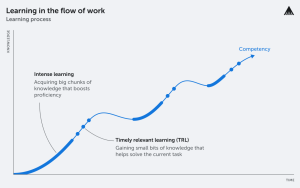Imagine this: you’ve spent a bunch of money on training for your team, but they just won’t take it up. Or only a few people actually do. And the ones who do only take the mandatory training for compliance or something. They never take the initiative to learn on their own. It’s like you have to spoonfeed them everything they need to know.
Sound familiar?
If so, you’re not alone. A lot of businesses struggle with this. But it doesn’t have to be that way. You can do a few things to create a culture of learning and development in your team.
Our team, clients, and some of the most successful businesses worldwide have tried and tested these tips!
1. Lead by Example
This may sound like a cliche, but we promise you that leading the way in learning and development could be the key to unlocking your team’s learning spirit.
To lead by example means letting your actions do the talking. How? By taking up a course or two yourself. Or by sharing interesting things you learned from an experience, a course you took, or an educational piece of content you watched.
You can take this further by encouraging them to share their learnings. This is exactly what one of our most active clients does. She holds team meetings where she encourages everyone (including herself) to share something they learned during the month.
When your team members see you doing this and see positive results in your work/life, they will also tend to pick it up.
2. Incorporate Learning Metrics into Performance Reviews
Does their learning get noticed? Is it appreciated during their appraisals? If not, it is time to include it in there.
And don’t just stop there, which is a mistake we’ve seen some businesses make. Go one step further to ask how they have incorporated that learning into their work. Beyond the certificate they gained, how did the learning change their day-to-day lives?
This gets them to connect the information they take into their output. And it will help you measure the impact of their learning. As a bonus, it also helps you determine how effective the training you put money into is.
3. Provide Incentives: Recognize and Reward Learning

Recognition and rewards are powerful motivators. When you acknowledge and celebrate your team’s commitment to learning, you reinforce the value of ongoing development, encouraging them to take it up. Learn more about the reinforcement theory to find other areas you can use it for your team.
So how do you reward them? It could be as simple as adding a “Learning Superstar of the Month” on your internal communications, like the email newsletter. Or you can reward them with a small prize, a certificate, or a shout-out during team meetings.
Ensuring they know that their dedication to learning is acknowledged also brings out inner feelings of pride and joy in the act, which is a powerful motivator to keep achieving greater things.
4. Encourage Ownership of the Learning Journey
Empower your team members to take charge of their own learning journey. Provide them with options and resources to choose their preferred learning paths. They can then choose the ones that align with their interests and career goals. Encourage them to set personal learning objectives and check in periodically to discuss progress.
5. Integrate Learning into Daily Work
Learning doesn’t have to be a separate activity—it can be seamlessly integrated into daily work routines. And mixing up moments of intense learning (uninterrupted sessions of learning) with more learn-by-doing moments, you get the best of both worlds. Here’s a diagram that shows this:

Source: Valamis
For instance, encourage asking questions at work. If they don’t know something, encourage them to ask! This provides multiple learning points in their day.
Assigning challenging tasks to people also pushes them to learn. So try it out with your team, too! This one goes best with a culture that’s open to asking questions. So they can get support when stuck, allowing them to learn and grow within their role.
By following these five actionable tips and leveraging real-world examples, you can create an environment where learning is celebrated, continuous improvement is encouraged, and your team becomes a powerhouse of knowledge and innovation. A culture of learning is an investment in your team’s success and your organization’s future.
Which of these will you be trying first? Let us know in the comments section.